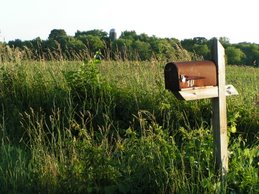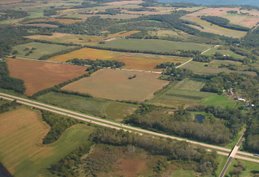To: Ruekert Mielke
From: Samuel Cooke, Fitchburg
Subject: Review of Ruekert Mielke Northeast Neighborhood Conceptual Storm Water Management Plan - Draft
I want to express my appreciation to City of Fitchburg staff and elected officials for commissioning the Ruekert Mielke May 2007 report, Northeast Neighborhood Conceptual Storm Water Management Plan – Draft. As stated in the Ruekert Mielke plan, the northeast corner of Fitchburg is in an area that has many important natural features that deserve protection and careful consideration. With Nine Springs Creek and E-way to the north, Lake Waubesa to the east, Swan Creek and Murphy Creek to the south I was especially interested in how the engineers and planners preparing this plan would conceptually address the stormwater management issues. As a sensitive area of Dane County, the Northeast Neighborhood is certainly unique to most parts of Fitchburg. Therefore, the stormwater management needs to be implemented with a higher level of care than most other parts of Fitchburg. Consistent with what the plan presented, the stormwater management standards, because of the location and proximity to the sensitive natural areas, needs to exceed the current City of Fitchburg standards. This is needed because we don’t just need to control and manage the stormwater but we also need to allow these sensitive areas to start recovering from the degradation that has already occurred from other developments and from modern agricultural methods. This recovery would be consistent with what an overwhelming majority of Fitchburg residents indicated when they completed a Fitchburg planning related survey a few years ago. The majority of Fitchburg residents placed protection of agricultural land and protection of natural resources as their top priorities, when it came to City planning issues. So, again I applaud the efforts to act responsibly and carry out the desire of an overwhelming majority of Fitchburg residents, by focusing on stormwater management issues. Here are my comments and questions, as well as a list of identified typos:
COMMENTS AND RECOMMENDATIONS (Please add these to the plan)
1) Provide Guidelines for Separate Construction and Long-term Stormwater Management Controls - One of my main concerns is regarding the requirements that should be in place during construction at the site. It is at that time when there is the opportunity for the highest concentrations of sediment (total suspended solids) and, with it, the higher concentrations of the other pollutants of concern, to leave the site and damage the neighboring sensitive natural areas. As you know, stormwater management controls are typically installed for the long-term benefit of the development while often, during construction, large quantities of sediment and other pollutants (e.g., spilled diesel, trash, dead vegetation, etc.) are attempted to be temporarily treated/filtered/contained using sediment fencing, riprap, straw bales, erosion mats, filter socks and other means. But the stormwater management controls in place during construction often fail to treat/filter/contain the worst runoff. Over the past several years, during several high runoff rate storm events, I have witnessed stark examples of this type of failure. At two developments, that are direct neighbors to my two Lacy Road properties, the interim stormwater control measures tried to treat/filter/contain the runoff but failed because of the quantity of rain and the inability of the control methodologies to adequately treat/filter/contain the large flows of muddy runoff from the completely bare site. I stood there and watched as the rain poured, the mud flowed and the contractors/developers shrugged their shoulders. I know this is a widespread problem and the effective solution requires a concerted effort and partnership between the planners/designers, contractors, the City Department of Public Works and the City Building Inspection Department. But, because this is the planning stage of this project I propose that the following issues be included and handled separately in the final conceptual stormwater management report:
2) Provide Enhanced Stormwater Management Standards – Another concern is the level of treatment that is being recommended. I appreciate the fact that the plan states the importance of the sensitive natural areas that exist along three of the four borders. I also appreciate the fact that the plan exceeds the City of Fitchburg Standards for Infiltration (Residential), Infiltration (Non-Residential), Wetland Protection and Thermal Control. With the sensitivity of the areas surrounding the proposed development area, I agree that the normal City of Fitchburg Standards should be reviewed for this development and made to be more stringent. I agree with the more stringent recommendations that have already been recommended and would like to see all of them in the final plan. Consistent with what has been done already I believe the other standards should be raised as well, especially for Total Suspended Solids (TSS). I propose that the TSS reduction goal of 80% should be increased to 90% based on a 2-yr, 24-hr storm event. This is based on the proximity to the wetlands and Northern Pike fishery at the southern tip of Lake Waubesa. Sediment loading to these areas must be limited in an attempt to turn around the degradation that has already occurred. Along with that increase in the TSS reduction goal I recommend that the off-site soil loss limit of 7.5 tons per acre (Erosion Control Standard) annually should be decreased to 5 tons per acre annually. This could be accomplished through the consistent enforcement of construction erosion control practices, street cleaning and the use of added detention, auxiliary filtration and other techniques. In addition, during construction and post-development, specific treatment for phosphorus reduction is needed because of the possibility of eutrophication of Lake Waubesa, limited only by the potential phosphorus loading (perhaps this could be addressed through the more stringent TSS reduction goals but it should be shown that phosphorus is expected to be treated).
3) Specify a Stormwater Site Inspection and Enforcement Plan – With any standards there, of course, needs to be site inspection and enforcement during construction and post-development for the stormwater controls that are specified and installed. The City of Fitchburg already has strong Building Inspection and Stormwater Utility District Departments. However, with stormwater management standards that are more stringent than elsewhere in Fitchburg, a site inspection and enforcement plan, that provides for those changes, is critical to the implementation of this stormwater management plan. Particular attention needs to be made to enforcement during construction. Therefore, it would be of benefit to have a conceptual outline of what enforcement steps are needed to proper implement the conceptual stormwater management plan so that those who are assigned to inspect know the differences to expect between this site and the normal Fitchburg construction site.
4) Additional Information is Needed to Prepare an Effective Design - I agree with the plan’s recommendations that the following additional studies and reports should be prepared prior to, or as a part of, site specific stormwater management plan completion: Groundwater study (including storm water recharge, water quality and spring flow protection), Definition of environmental corridor issues (wetland delineation, cultural archeological resources and endangered species identification), Site specific investigations (type of soils, depth of bedrock, depth of groundwater, infiltration and recharge rates). Furthermore, I agree with the suggestion on Page 57 to further evaluate and update the existing Dane County groundwater model as part of an overall effort to improve the accuracy of groundwater related predictions. Ken Bradbury (Wisconsin Geologic and Natural History Survey) should be contracted to perform this much needed update.
5) Implement Dane County Water Quality Plan – I agree with the references to the fourth Framework Plan (Pages 9 and 10) when it says that Fitchburg should: “…enforce infiltration maximization measures to protect Nine Springs Creek base flow; vigorously enforce and expand comprehensive erosion control and stormwater management requirements beyond the minimum standards of the Dane County Ordinance to protect Nine Springs Creek from the adverse impacts of development; revise building ordinances to require roof drainage to grassed areas, where feasible, for new development.” This is another reason why Comment No. 2, above, is needed. Either in the conceptual or the more detailed, site specific stormwater management plan the other elements of the Dane County Water Quality Plan should be discussed and a commitment made to implement those measures.
6) Potential for Damage to the Sensitive Natural Areas Should Far Outweigh Stormwater Management Cost Issues – I ask that you read in the July/August 2007 edition of Stormwater magazine (The Journal for Surface Water Quality Professionals) the article on “Stormwater Management as Adaptation to Climate Change” (Page 50 in the magazine). In the first paragraph of that article, the Intergovernmental Panel on Climate Change (IPCC) is cited as saying that there will be: “…a 90% chance of increased frequency of heavy rainfall events, heat waves, and hot extremes in the 21st century.” The article goes on to say, in the second paragraph: “This news comes at a time when many fundamental aspects of infrastructure management are being questioned and appear to be changing radically and in ways that will aid adaptation to climate change.” With global climate change being so unpredictable, and the modeling for the stormwater management systems being based on 1981 precipitation data, I recommend that more controls be assumed to be needed than less controls. However, on page 28 of the conceptual stormwater management plan, at the top of the page, there is the sentence: “The [stormwater management] systems should be cost effective, meeting the objectives at the lowest practicable cost.” Although I appreciate the fact that the “lowest practicable cost” is an important part of a normal design I think that, with the sensitive areas surrounding this part of Fitchburg, finding the cheapest way to “meet the objectives” should not be the emphasis. I would recommend that the final stormwater management design should lean heavily toward the better and more flexible solutions rather than the lowest cost of the currently available alternatives. Please have the plan reflect the above general sentiments.
7) Establish Recharge Rates Based on 7.6 inches per year PLUS the Amount of Groundwater Extracted for Use – I know this would be a departure from the established recharge design criteria but I am suggesting that the development be made to be sustainable and compensate for not only the loss of pervious surface, due to development, but also compensate for the extraction of groundwater that come with having additional households, businesses, etc. The true and sustainable recharge should account for not only the water not making its way back into the aquifer(s) but also the amount of water extracted for use by those inhabiting and visiting the developed area.
8) Establish a Public Education Plan – The need for public education and public involvement is mentioned several times in the plan. I agree with this and know that it not only needs to be performed initially but also on a consistent basis. The people who inhabit the development 10 and 20 years from now will have just as much impact (or more) as the people who would inhabit the development the first year. A long-term public education plan needs to be laid out either by the City, as a separate document, or conceptually within this plan, as part of the Northeast Neighborhood development. What are the suggested ways of carrying out the public education component of the conceptual plan?



No comments:
Post a Comment